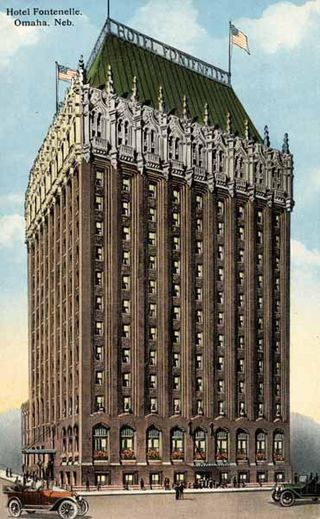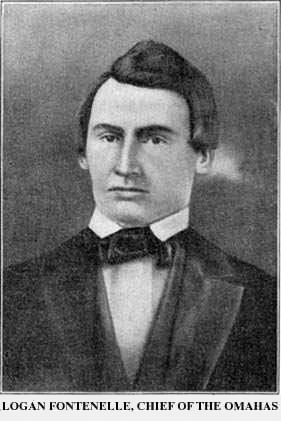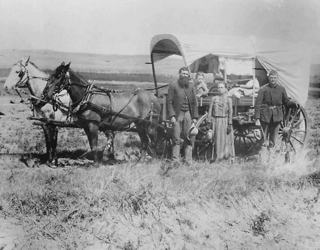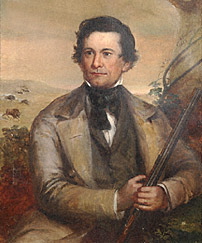Publication
The full name of the paper was the Nebraska Palladium and Platte Valley Advocate; its name came from the palladium in classical antiquity, in which a xoanon of Athena was said to protect Troy. After Daniel E. Reed and his wife moved to the territory from New England, they and journalist Thomas Morton founded and published the paper in Bellevue, Nebraska, in 1854. [upper-alpha 1] It was the first newspaper published in the Nebraska Territory, [upper-alpha 2] though some of its earliest issues were printed in St. Mary, Iowa. [upper-alpha 3] The publication of the first issue was a momentous occasion for Nebraska politicians: Thomas B. Cuming, who was acting as the territorial governor, worked on the first proof sheet, and Fenner Ferguson, the chief justice of the territory's supreme court, was its reader. Reed declared that the event "may seem unimportant now" but "will form an epoch in history, which will be remembered ages after those present on this interesting occasion, are no more". [upper-alpha 4]
The paper published poetry, reports on the musical life of Nebraska, and it had a distinctive political perspective: It advocated for Bellevue to become the territorial capital over Omaha. It rivaled the Arrow , [upper-alpha 5] edited by Joseph E. Johnson, a Mormon, who sought to increase settlement in Omaha and make it the capital. After Johnson's Arrow collapsed, he created the Bugle , which continued his agitation to mark Omaha as the capital; ultimately, he succeeded, and the Nebraska Palladium blamed Johnson for its selection. The editors at the Nebraska Palladium printed a fake letter from Joseph Smith, the founder of Mormonism, to Johnson: The letter contained congratulations to Johnson for exercising "deceit in flattery", suggested that Johnson "let no lies stay you (I have no fears)", and announced that Omaha was a suitable city.
Its readership extended from the Nebraska Territory into Iowa, and it frequently received letters from Iowan readers.

Bellevue is a suburban city in Sarpy County, Nebraska, United States. It is part of the Omaha–Council Bluffs metropolitan area, and had a population of 64,176 as of the 2020 Census, making it the third-largest city in Nebraska, behind Omaha and Lincoln, and the second largest city in the U.S. named "Bellevue," behind Bellevue, Washington.

The Platte River is a major river in the State of Nebraska. It is about 310 mi (500 km) long; measured to its farthest source via its tributary, the North Platte River, it flows for over 1,050 miles (1,690 km). The Platte River is a tributary of the Missouri River, which itself is a tributary of the Mississippi River which flows to the Gulf of Mexico. The Platte over most of its length is a broad, shallow, meandering stream with a sandy bottom and many islands—a braided stream.

The Territory of Nebraska was an organized incorporated territory of the United States that existed from May 30, 1854, until March 1, 1867, when the final extent of the territory was admitted to the Union as the state of Nebraska. The Nebraska Territory was created by the Kansas–Nebraska Act of 1854. The territorial capital was Omaha. The territory encompassed areas of what is today Nebraska, Wyoming, South Dakota, North Dakota, Colorado, and Montana.

Thomas B. Cuming was an American military officer and politician. He served as the first Secretary of Nebraska Territory and served twice as the territory's Acting Governor, the first time following the death of Francis Burt and the second following the resignation of Mark W. Izard.

The following is an alphabetical list of articles related to the U.S. State of Nebraska.

The history of Omaha, Nebraska, began before the settlement of the city, with speculators from neighboring Council Bluffs, Iowa staking land across the Missouri River illegally as early as the 1840s. When it was legal to claim land in Indian Country, William D. Brown was operating the Lone Tree Ferry to bring settlers from Council Bluffs to Omaha. A treaty with the Omaha Tribe allowed the creation of the Nebraska Territory, and Omaha City was founded on July 4, 1854. With early settlement came claim jumpers and squatters, and the formation of a vigilante law group called the Omaha Claim Club, which was one of many claim clubs across the Midwest. During this period many of the city's founding fathers received lots in Scriptown, which was made possible by the actions of the Omaha Claim Club. The club's violent actions were challenged successfully in a case ultimately decided by the U.S. Supreme Court, Baker v. Morton, which led to the end of the organization.
The Nebraska Territorial Legislature was held from January 16, 1855 until 1865 in Omaha City, Nebraska Territory.

Logan Fontenelle, also known as Shon-ga-ska, was a trader of Omaha and French ancestry, who served for years as an interpreter to the US Indian agent at the Bellevue Agency in Nebraska. He was especially important during the United States negotiations with Omaha leaders in 1853–1854 about ceding land to the United States prior to settlement on a reservation. His mother was a daughter of Big Elk, the principal chief, and his father was a respected French-American fur trader.

The history of the U.S. state of Nebraska dates back to its formation as a territory by the Kansas–Nebraska Act, passed by the United States Congress on May 30, 1854. The Nebraska Territory was settled extensively under the Homestead Act of 1862 during the 1860s, and in 1867 was admitted to the Union as the 37th U.S. state. The Plains Indians are the descendants of a long line of succeeding cultures of indigenous peoples in Nebraska who occupied the area for thousands of years before European arrival and continue to do so today.
The Omaha Claim Club, also called the Omaha Township Claim Association and the Omaha Land Company, was organized in 1854 for the purpose of "encouraging the building of a city" and protecting members' claims in the area platted for Omaha City in the Nebraska Territory. At its peak the club included "one or two hundred men", including several important pioneers in Omaha history. The Club included notable figures important to the early development of Omaha. It was disbanded after a ruling against their violent methods by the U.S. Supreme Court in 1860 in Baker v. Morton.

Alfred D. Jones was a late 19th-century lawyer, surveyor and politician in the Midwestern United States. In 1846 he platted Fort Des Moines, Iowa, and in 1854 he platted Omaha, Nebraska. He became the first settler in Omaha, as well as the first postmaster, a member of the first Omaha City Council and the first Omaha School Board, and was among the first legislators of the Nebraska Territory.

Transportation in Omaha, Nebraska, includes most major modes, such as pedestrian, bicycle, automobile, bus, train and airplane. While early transportation consisted of ferries, stagecoaches, steamboats, street railroads, and railroads, the city's transportation systems have evolved to include the Interstate Highway System, parklike boulevards and a variety of bicycle and pedestrian trails. The historic head of several important emigrant trails and the First transcontinental railroad, its center as a national transportation hub earned Omaha the nickname "Gate City of the West" as early as the 1860s.
Joseph Ellis Johnson was an American Mormon newspaper proprietor, politician, and businessman.

The Grand Island Independent is a newspaper published in Grand Island, Nebraska. The Independent is published seven days a week but does not produce a newspaper on Christmas Day. Its daily circulation is 10,384 in eleven counties of central Nebraska. The newspaper is owned by the Omaha World-Herald Co.

The Great Platte River Road was a major overland travel corridor approximately following the course of the Platte River in present-day Nebraska and Wyoming that was shared by several popular emigrant trails during the 19th century, including the Trapper's Trail, the Oregon Trail, the Mormon Trail, the California Trail, the Pony Express route, and the military road connecting Fort Leavenworth and Fort Laramie. The road, which extended nearly 370 miles (600 km) from the Second Fort Kearny to Fort Laramie, was utilized primarily from 1841 to 1866. In modern times it is often regarded as a sort of superhighway of its era, and has been referred to as "the grand corridor of America's westward expansion".
James C. Mitchell (1810-1860) was an early settler of Bellevue, Iowa and went on to the found the town of Florence in the Nebraska Territory in 1854.

Peter Abadie Sarpy (1805–1865) was the French-American owner and operator of several fur trading posts, essential to the development of the Nebraska Territory, and a thriving ferry business. A prominent businessman, he helped lay out the towns of Bellevue and Decatur, Nebraska. Nebraska's legislature named Sarpy County after him in honor of his service to the state.
The First Nebraska Territorial Legislature first met in Omaha, Nebraska, on January 15, 1855. The Council Bluffs and Nebraska Ferry Company provided the first meeting place, which was a building "constructed for public purposes". Standing out from the estimated twenty shacks in the young town, it was the first brick building in Omaha, which was founded the year before when the Nebraska Territory was created. Responsible for several important decisions that laid an important foundation for the future statehood for Nebraska, the Nebraska Territorial Legislature made controversial decisions and provided leadership for the territory.
Significant events in the history of Omaha, Nebraska, include social, political, cultural, and economic activities.













